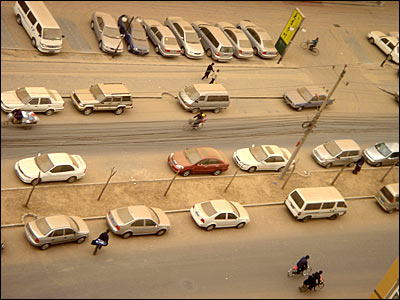| Tools: Save | Print | " target="_blank" class="style1">E-mail | Most Read |
| More Dusty Conditions Forecast |
| Adjust font size: |
|
Meteorologists have warned that dusty conditions will continue to prevail in many parts of northern China today and in the coming few days.? In Beijing residents woke up yesterday morning to one of the dustiest days of the year with the ground, cars and everything else outside covered with a layer of dust.
Yang Keming, leading forecaster with the Central Meteorological Office, said the main reason for the dusty weather in Beijing, which he described as the most serious since 2003, was sand being blown by a severe storm which originated in Mongolia and Inner Mongolia on Sunday.
He added that the significant amount of vehicle emissions and the floating dust from construction sites in Beijing were making matters worse.
"This is definitely one of the most serious pollution days in Beijing," he told China Daily, adding that visibility in Haidian District fell to 400 meters.
He said that the dusty conditions in Beijing would end around noon today when a force 3-4 northwest wind would blow the dust away.
The conditions brought much inconvenience to city residents.
"It was like a dust sort of rain," said An Zengming, a doorman at the Yinghua Hotel near the Fourth Ring Road in Chaoyang District.
"My clothes got dirty shortly after I began standing here at 7 am," he said ruefully while blowing dust off his cap.
Wang Hui, an accountant who came to Beijing from Dalian, a port city in northeast China's Liaoning Province, said that inspired by her older neighbors, she'd bought face muffles for her family. "This (the dust) is definitely bad for my health," she said. "This never happens in Dalian."
Yang advised people to avoid outdoor activities and to wear mouth muffles or scarves if they were walking. "Small children are better to stay at home during such days," he said.
The dusty conditions will continue in the coming few days in most of northern China with severe sandstorms predicted to hit the middle-western part of Inner Mongolia, the Central Meteorological Office said.
A severe sandstorm hit central Inner Mongolia yesterday afternoon with the visibility in the worst-hit areas falling to 200 meters.
The State Forestry Administration (SFA), which monitored the conditions, said that the latest dust storms affected more than 500 counties within 10 provinces in northern China and covered an area of about 1.6 million square kilometers. Around 200 million people had been affected.?? ?
Kang Ling, deputy director of the Inner Mongolian Meteorological Observatory, said the dry weather and sudden temperature variations were a major factor in dust levels this spring. Nine days of dusty conditions, including six sandstorms, had occurred in Inner Mongolia so far this spring, she added. ?
Liu Tuo, director of the sand prevention and control office under the SFA, said it was impossible to eliminate the sandstorms under current conditions. ?
"The source of China's sandstorms originates not only from the vast, sandy areas in northern China but also some foreign countries," he said.
The current 1.7 million square kilometers of sandy soil and deserts in northern China cannot be reclaimed in a short time, added Liu.
(China Daily April 18, 2006) |
| Tools: Save | Print | " target="_blank" class="style1">E-mail | Most Read |
 |
| Related Stories |


